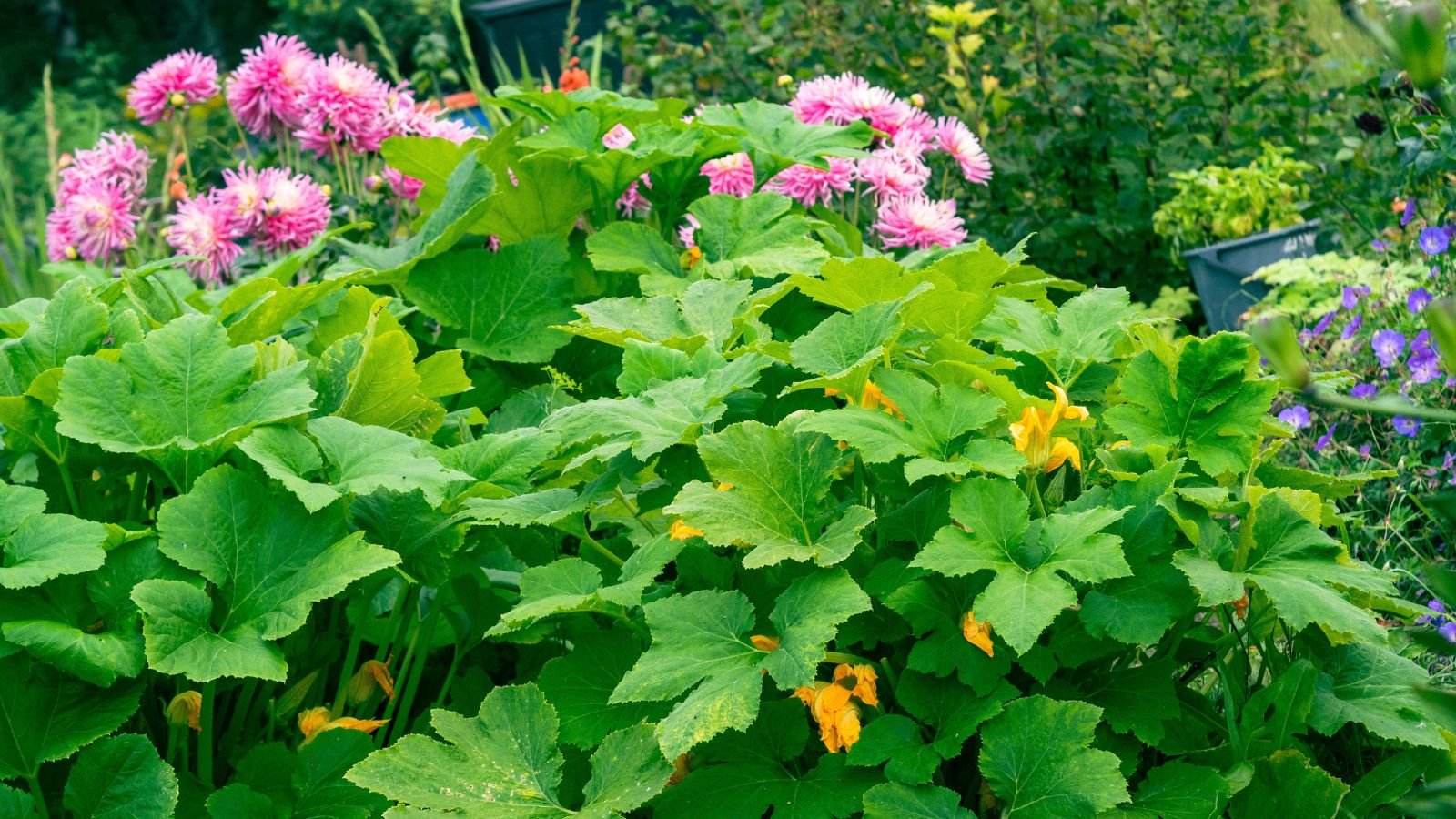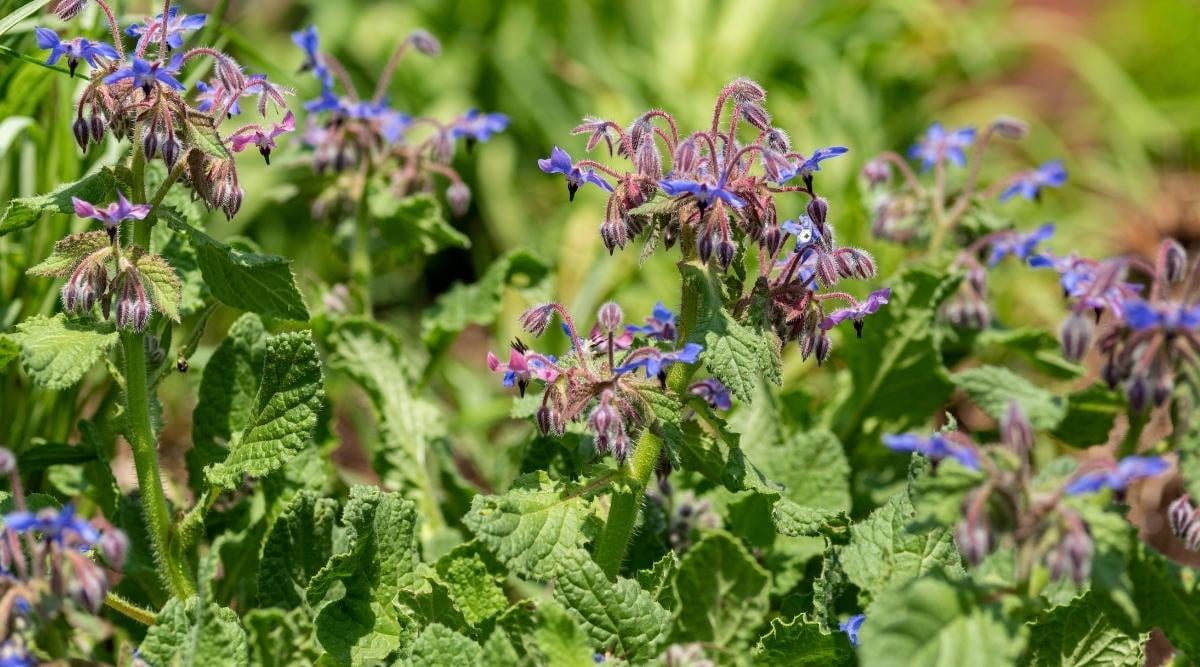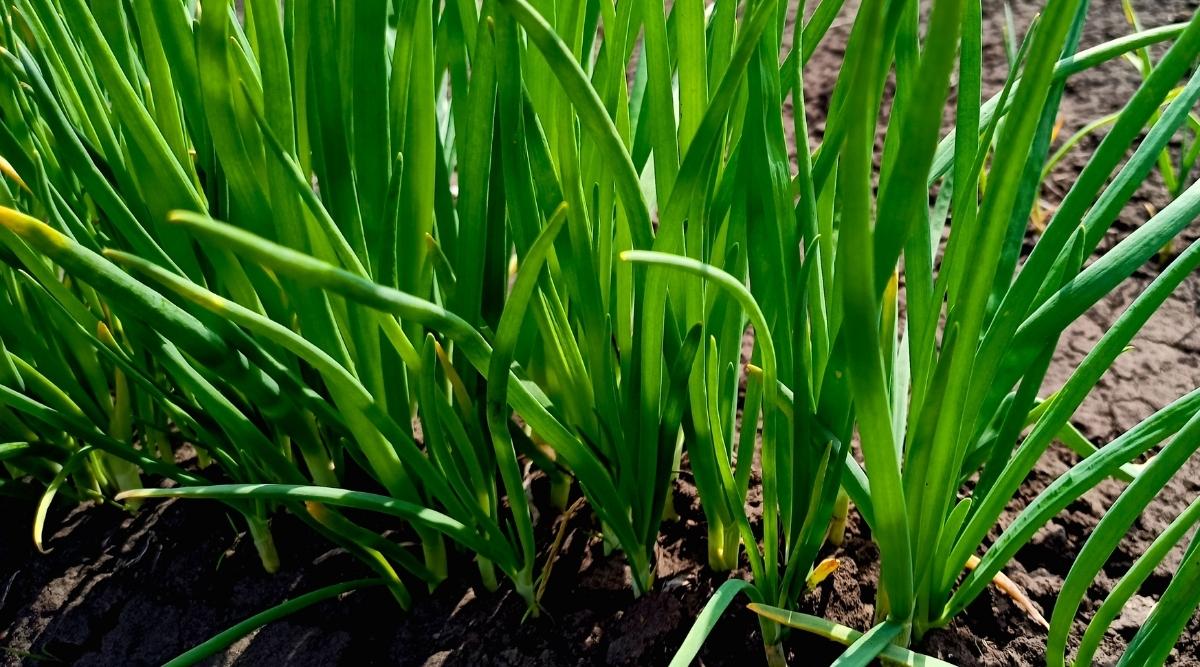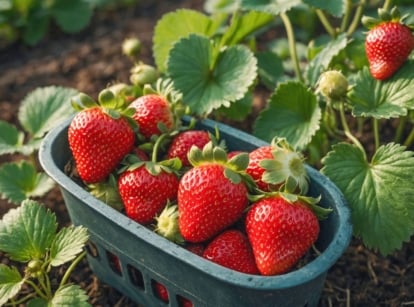27 Best Zucchini Companion Plants (and What to Avoid)
Thinking of adding some companion plants to your zucchini garden, but aren't sure what to pair them with? There are plenty of plants you can grow with zucchini, even if it tends to take over a garden area. In this article, gardening expert and former organic farmer Logan Hailey walks through her favorite zucchini companions for the garden.

Contents
With their many uses in the kitchen and low maintenance requirements, zucchini are among the hardest-working garden vegetables around. They also happen to be some of the fastest-growing vegetables for new gardeners. Zucchini are like the gift that keeps on giving: you plant them once and harvest their blossom-ended squash all summer long.
But these vigorous summer squash can still fall victim to a range of issues. From cucumber beetles to powdery mildew to aphids and powdery mildew to bacterial wilt, pests and diseases can put a serious dent in your zucchini harvest. And if you’re lacking in bees to pollinate the yellow squash blossoms, say goodbye to your potential harvests!
Thankfully, age-old garden wisdom has finally met the world of scientific research to bring us the power of companion planting. By combining compatible vegetables, herbs, and flowers with zucchini, you can maximize your yields, biodiversity, and use of space while simultaneously cutting down on pesky crop problems.
Plus, these plants beautify your garden and bring on all those lovely bees and pollinators that make for a robust, thriving ecosystem. Let’s dig into our favorite zucchini companion plants, as well as what not to plant with them!
Top Zucchini Companion Plants
Choose flowers, herbs, and/or vegetable companions to aid your zucchini’s growth and reduce the need for weeding or harmful pesticides in the garden. There are many different options to choose from. Let’s take a deeper look!
Sweet Alyssum

With its sweet-smelling tiny white flowers and low-growing habit, sweet alyssum is the quintessential zucchini companion plant. It’s an all-in-one staple for your garden: it helps keep pests under control by attracting predatory insects like ladybugs and parasitic wasps. It also looks beautiful, smells great, and draws in tons of bees to pollinate your squash.
Alyssum is a fast-growing companion that is scientifically proven to prevent aphid infestations without competing with your crops for light, nutrients, or space. When paired with zucchini, it can drastically reduce pest pressure while improving yields through increased pollination.
Benefits
Repels pests, attracts predators, and improves squash pollination
How to Plant it
Alyssum takes about 50 days to begin flowering, so seed it just before transplanting your zucchini into the bed. Plant this lovely flower at all the row ends or scattered throughout the zuke patch. The more the merrier! Leave 10-12” of space between alyssum plants and zucchini so they don’t get shaded out by the big squash leaves.
Calendula

A popular daisy-family flower, calendula has ultra-resinous, fragrant blooms. Though it’s commonly called “pot marigold”, it’s not actually related to marigolds. However, its vibrant orange flowers and insect-attracting properties make it equally as beneficial.
Aphid-eating lacewings, hoverflies, and parasitic wasps love feeding on the high pollen content of calendula flowers. As a bonus, this plant is highly medicinal for your skin and digestive system.
Benefits
Attract beneficial predators and pollinators
How to Plant it
Scatter calendula anywhere in your garden, leaving 12” between this herb and other plants. Calendula can get overtaken by zucchini, so it’s best sown in patches along the margins of a raised bed or at the ends of a row. As the calendula flowers mature and dry, scatter the seeds in place to keep the patch expanding. You shouldn’t have to worry about any competition with your zucchini plants.
Clover

Both white and red clover are often used as cover crops, but they are also excellent nitrogen-fixing living mulches. When sown around zucchini raised beds or in pathways, clover flowers attract all the lovely beneficial insects while simultaneously suppressing weeds and holding in soil moisture.
These fragrant blossoms can improve squash pollination and reduce pest pressure in your zucchini. Clover grows naturally, but can get a bit unruly if left unmaintained.
Benefits
Fixes nitrogen, attracts beneficial insects, and acts as living mulch to compete with weeds
How to Plant it
Some clovers can be very aggressive, so it’s important that your zucchini get established ahead of time and/or you keep clover in the pathways rather than in the beds. You can achieve this by heavily mulching under zucchini with straw or leaves that prevents the clover from creeping in.
Borage

A popular plant with star-shaped turquoise flowers, borage attracts bees and other pollinators. This bushy zucchini companion plant can help keep cucumber beetles away from your zucchini. It brings in loads of bees to improve pollination rates for bigger, juicier squash.
Moreover, borage has deep taproots that “mine” minerals and water from deep in the soil to make them more available to nearby crops.
Benefits
Attract beneficial predatory insects, improve pollination, and accumulate minerals
How to Plant it
Borage is a fairly large plant that can keep up with zucchini without risking overgrowing it. Transplant these companions at the same time, leaving about 18” between the zucchini and the borage plant.
Nasturtiums

Tropaeolum spp., otherwise known as nasturtiums, are playful morning glory-family flowers that come in a rainbow of colors. They are absolute magnets for hoverflies, parasitic wasps, and ladybugs.
The spicy aroma repels pests and lures them away from your zucchini. The flowers are also edible and have a delicious peppery flavor perfect for garnishing summer salads.
Benefits
Repel pests, attract beneficial predators, and attracts pollinators
How to Plant it
Nasturtiums can vine up to 10 feet tall and spread more than 3 feet wide, so be sure you have plenty of room for them to grow and flower. They are perfect when sown along the perimeter of your veggie beds or vining near a row of zucchini. Maintain a solid 18-24” between nasturtiums and their neighbors so you don’t end up with a flower patch taking over your squash!
Marigolds

French marigolds have been researched extensively for their pest-repellant properties in both greenhouse and outdoor settings. They repel insect pests above-ground and suppress root knot nematodes below-ground.
The strong aroma of the flowers and certain compounds in the roots make it an all-around workhorse companion. Marigolds can even help keep rabbits and rodents away from your squash. Plus, pollinators love them, and they are beautiful additions to bouquets.
Benefits
Repel pests, deter root knot nematodes, and attract pollinators
How to Plant it
Be sure to select the more compact French marigold varieties (as opposed to Mexican marigolds). Plant them every few feet around the perimeter or row ends of your zucchini beds. Keep 12-18” between neighboring zucchinis and marigolds so the flowers don’t get overgrown.
Phacelia

One of the best insectary plants on the planet, phacelia (P. tanacetifolia) is a showstopper, quick-growing floral companion plant for zucchini. Phacelia is in the Boraginaceae (borage) family and shares many similar properties with borage flowers.
With its lacy fern-like foliage and curled bell-shaped purple blossoms, phacelia is as beautiful as it is useful. Bees are absolutely addicted to phacelia! When planted near zucchini, you will probably never have to worry about your squash pollination again.
Benefits
Attract pollinators and beneficial insects
How to Plant it
Phacelia is the perfect peak-summer companion for zucchini because it matures in approximately the same time frame. Direct seed at the same time as squash, leaving 18-24” of space from neighboring zukes. It is also great for clump plantings in border beds.
Bachelor’s Buttons

A popular annual, Bachelor’s buttons are dazzling annual flowers with a knack for attracting all sorts of beneficial pollinators. The pom-pom-shaped blossoms bloom nonstop throughout the hottest conditions, making them a perfect match for zucchini’s rugged summer performance.
Sometimes called cornflower, bachelor’s buttons are not fussy about soil conditions and won’t compete with your squash for nutrients.
Benefits
Attract pollinators and beneficial insects
How to Plant it
Direct seed bachelor’s buttons about 12-18” from zucchini plants or in large clumps on the borders of beds. You can allow them to self-sow and come back year after year without risk of them taking over your garden.
Bee Balm

The scented leaves of bee balm are intensely fragrant and have high concentrations of essential oils that repel a range of pests. The vibrant, poofy flowers also attract bees, butterflies, and beneficial predators to your squash patch.
Bee balm is super low maintenance and comes back year after year for continuous companion support. This popular flower is also native to the United States, making it a perfect companion for gardeners who prefer native flowering plants.
Benefits
Repels pests, attracts pollinators and beneficial predatory insects
How to Plant it
Bee balm is a perennial best kept out of your annual beds. These bushes can grow up to 4 feet tall and spread 3-4 feet, so plant them in the perennial herb margins of your garden within a few yards of zucchini beds.
Snapdragons

These tall spike-shaped flowers look incredible rising up from a verdant broad-leaved blanket of zucchini squash. The bell shape of the blossoms makes for beautiful cut flowers and draws in all sorts of bumble bees and native bees with their delicious scent.
Benefits
Attract pollinators
How to Plant it
Seed snapdragons in the spring 3-4 weeks before transplanting zucchini. They can be planted in a row alongside zucchini crops or scattered in between every few plants. Be sure that the snapdragons are about 6” tall by the time you plant zucchini and leave them 12-18” of space from each other. With their cold tolerance, snapdragons will even outlast your zucchini plants into the fall.
Yarrow

Known for its beautiful lacey foliage, yarrow blooms with umbel-shaped flowers in creamy white, pastel pink, or vibrant yellow hues. Parasitic wasps and hoverflies obsess over yarrow, meaning that your aphid and cucumber beetle populations could be drastically reduced in your zucchini patch. Honey bees also love yarrow and can help with pollinating your squash.
Benefits
Attract beneficial predatory insects and pollinators
How to Plant it
Seed yarrow about a month before planting zucchini and provide it at least 24” of space from neighboring squash plants. It works great in the four corners of a raised bed or planted every 6 feet within a row. I prefer the classic native wildflower yarrow to its colorful domesticated counterparts, but any variety of lavender will do.
Echinacea

Also called coneflower, echinacea is naturally bug repellent, particularly for squash bugs and aphids. While it keeps these pests away from zucchini, it also draws in the pollinators you need for healthy, robust squash harvests.
This popular annual is also referred to as purple coneflower. They are also native to the United States, and are a perfect flower for those individuals looking to plant native species alongside their vegetable garden.
Benefits
Repel pests and attract beneficial insects
How to Plant it
Echinacea needs at least 18-24” of space per plant and takes a year or two to flower. As a hardy perennial, it is best planted in herbal border beds rather than directly in your squash beds. Giving echinacea this patience and space will reward you with an abundance of beautiful cone-shaped pink blooms and pest-reducing assistance in the garden.
Zinnias

A lover of warm weather and full sunlight, zinnia thrives in similar conditions to zucchini. These colorful flowers help protect squash from pests while adding splashes of color and beauty throughout the garden.
Benefits
Attract pollinators
How to Plant it
Zinnias are subtropical plants that require the same warmth as zucchini. You can transplant them into the garden at around the same time, interplanting every few feet with your squash seedlings (as well as tomatoes or peppers).rnrnThe only downside to companion planting with zinnias is the possibility for powdery mildew infection, which could easily spread to your squash. To avoid this, cut back or uproot tired old zinnia plants before they succumb to any diseases.
Dill

The giant umbel flowers of dill attract a huge diversity of ladybugs, parasitic wasps, hoverflies, and other predators that eat aphids, thrips, and cucumber beetles. Some gardeners even report that young dill plants can improve the growth and vigor of zucchini seedlings.
Dill is a fairly low-maintenance herb and is easy to grow. It can be a bit unruly if left unmaintained, so don’t sleep on your maintenance schedule.
Benefits
Improve vigor and attract beneficial insects
How to Plant it
Transplant baby dill into the garden at the same time as zucchini, leaving about 12-18” of space between the plants. Harvest the leaves as desired and allow the plant to bolt into its full glory of summer flowers.
Mint

Mint can be a tricky plant to use as a companion because it is so aggressive. However, mint also has a notoriously strong fragrance that keeps bad bugs off your crops. When it flowers, it also attracts bees and beneficial insects for miles around.
Benefits
Attract pollinators and beneficials
How to Plant it
Given its crazy fast growth habit, mint can get a bit out of control when planted in the wrong place. Keep this herb out of your zucchini beds and instead plant it as a groundcover or pruned shrub in neighboring perennial beds.
Oregano

As one of the most popular pest control herbs, oregano is a great companion for almost all veggies. When it comes to zucchini, the peppery aromatic leaves of oregano keep squash bugs and aphids at bay.
As it bolts, the purple flowers provide important habitat and nectar-rich food for lacewings and other beneficial predators. This herb is also easy to care for and can grow in many different growing conditions.
Benefits
Repel pests and attract beneficials
How to Plant it
Plant versatile oregano in the borders or corners of your zucchini beds, leaving about 16-18” of space from neighboring plants. The low growth habit means it can get overgrown by your squash if planted too close.
Rosemary

Rosemary has a distinctive flavor and resinous leaves that repel all manner of pests, from squash bugs to cucumber beetles and beyond. The sprigs are perennial in zones 7 and warmer, and they taste great with zucchini in recipes.
Benefits
Repel pests
How to Plant it
Rosemary shrubs can grow incredibly wide and tall. They are best kept on the perennial margins away from your annual beds, yet within a few yards of zucchini crops.
Lavender

This Mediterranean native is incredibly popular for its sweet classic aroma and gorgeous beauty in the garden. But it isn’t only an ornamental: the strong fragrance of lavender leaves and flowers repels pests and draws in bees to help with zucchini pollination.
Benefits
Repel pests and attract pollinators
How to Plant it
Because they are both Mediterranean natives, you can plant lavender and rosemary in the same gravelly soil beds along the borders of a vegetable garden. Keep lavender shrubs a few yards from your zucchini.
Sage

Like its rosemary and lavender cousins, sage has a strong herbal smell that keeps bad bugs away. It tastes great in the kitchen and produces lovely flowers in peak summer. It’s another low-maintenance herb that’s easy to grow. It does require a bit of monitoring, as like other herbs, it can grow wildly if left alone.
Benefits
Repels pests and attract pollinators
How to Plant it
Keep sage on perennial borders with lavender and rosemary.
Thyme

Containing the powerful compound thymol, thyme is known for its antimicrobial and antifungal properties. In the garden, it uses this fragrance to fend off soil-borne pathogens (disease-causing organisms) as well as shooing away unwanted pests.
At the same time (no pun intended), thyme flowers attract beneficial insects to help your garden function like a thriving ecosystem that doesn’t need pesticides or fungicides.
Benefits
Prevent diseases, repel pests, act as ground cover, and attract beneficial insects
How to Plant it
Plant bushy thyme only on the margins of your zucchini patch. Alternatively, opt for a creeping thyme variety to use as a groundcover in the zucchini bed. Creeping thyme can tolerate moderate shade and foot traffic as it cools the soil, retains moisture, and suppresses weeds. It even provides a nice cushiony surface for baby zucchini to grow on without risking rotting in the soil.
Corn

The classic “three sisters” or milpa planting of Mexico and Latin America includes corn, bean, and squash planted in a symbiotic food forest of sorts. This trio provides numerous benefits to all crops involved.
The zucchini squash acts as a ground cover to shade out weeds and keep the soil moist. Meanwhile, the beans fix nitrogen that boosts the growth of both corn and zukes. The corn acts as a stalk for beans to vine up while simultaneously making use of bare spaces between zucchini plants.
We love that corn doesn’t compete with zucchini (as long as there is ample fertility in the soil) and won’t shade it out. The tall growth habit acts as the perfect complement to zucchini’s low, bushy shape.
Benefits
Maximize yields and add biodiversity
How to Plant it
Seed or transplant two rows of corn in mounds, then plant squash every 4 feet between them. If you want to add beans to the mix, plant bean seeds in a circle around each corn stalk. You can repeat the pattern for as long of a bed as you’d like.
Peas

Peas are also excellent nitrogen-fixers thanks to their association with rhizobium bacteria. These tiny microbes live in association with leguminous roots and help them transform atmospheric nitrogen into plant-available nitrogen.
This is great news for your zucchini crop because zukes are moderate to heavy feeders. They need plenty of nutrients to continuously produce.
Another added benefit to peas is their willingness to vine up a trellis without shading out the crops below. While the broad low leaves of zucchini keep the soil moist and weed-free, peas can maximize vertical space by winding up a T-post or cattle panel trellis.
Benefits
Fix nitrogen and maximize growing space
How to Plant it
Sugar snap peas are notoriously quick growing, but may not enjoy the hot summer weather that zucchini craves. Instead, opt for indeterminate (vining) shelling peas that can tolerate the heat while winding their way up a trellis in the zucchini patch.rnrnDirectly seed the peas at the same time as you transplant zucchini. Space them at least 12” from neighboring zucchini plants and provide a narrow, tall trellis such as a fence post.
Beans

Like peas, beans are the perfect nitrogen-fixing companion plants for zucchini. They grow quickly and maximize the vertical space above a zucchini canopy. Meanwhile, the zuke leaves shade out any competition.
Benefits
Fix nitrogen and maximize growing space
How to Plant it
Be sure to choose pole beans (bush beans will likely get overgrown by zukes). Trellis them just like the peas described above.
Tomatoes

Tomato is one of the best companion plants for zucchini because the giant leaves of zukes provide ground cover that keeps the soil cool and moist. The yellow blossoms of both crops attract pollinators to the patch. Simultaneously, the tomatoes are tall enough to withstand competition from the zucchini.
Benefits
Maximize yields, add biodiversity, and attract pollinators
How to Plant it
You can trellis indeterminate tomatoes or opt for bush (determinate) varieties with this interplanting technique. The trellised tomatoes have worked best for me because you can prune off the lower leaves and have plenty of airflow left between the zukes and tomato stems.
Transplant seedlings at the same time, leaving at least 18” of space between each tomato and neighboring zucchini plant. Prune the tomatoes to a single or double leader, then trellis them up a T-post nailed in between the zucchini crop.
Garlic

A popular season-long crop, garlic deters pests with its strong aroma. When grown as a zucchini companion plant, it can help keep aphids and cucumber beetles at bay.
Benefits
Repel pests
How to Plant it
Once you harvest a row of summer “green garlic” out of the center of your beds, plant in your zucchini seedlings just after the last frost of the spring. This timing will perfectly allow the adjacent garlic to continue maturing while the new zucchini takes off. Leave a minimum of 18” between rows of zukes and garlic.
Onions

Like garlic, the pungent, sulfury smell of onions is excellent for repelling zucchini pests. Their big bulbs also loosen the soil for shallow-rooted summer squash plants.
Benefits
Repel pests and maximize yields
How to Plant it
Transplant onions at the same time as zucchini about 24” from the baby zucchini plants. It’s best to keep onions in a clean row alongside the squash so you can alternate between each crop or border an entire raised bed with onions.
Peppers

Whether sweet or hot, peppers can easily thrive in the partial shade of nearby zucchini plants to prevent their fruits from scorching in the sun. These bushy tomato-family crops complement zucchini’s growth habit because they’re stout and compact, while zucchini are large and bushy.
They also have a notoriously long season that opens the window for filling bare garden space with zucchini plants. Peppers are also easy to grow and require minimal maintenance in the garden.
Benefits
Maximize yield and increase biodiversity
How to Plant it
Because they take far longer to mature (70-100 days depending on variety), it’s best to start pepper plants indoors at least a month before zucchini (which takes only 40-60 days). When it comes time to transplant, leave at least 18-24” of space between peppers and zucchini to prevent overcrowding.
Don’t Companion Plant These

While zucchini is relatively easy to please, it doesn’t get along with every vegetable. Companion planting with competitive crops is one of the most common companion planting mistakes new gardeners encounter. Keep it separated from these crops to avoid problems.
- Other Cucurbits: Cucumbers, pumpkins, winter squash, and melons will all attract the same pests and diseases. They can also easily cross-pollinate. They are best interspersed with beneficial companions or other veggies.
- Sweet Potatoes: The vining habit of sweet potatoes can easily clash with zucchini and create a weedy nightmare.
- Potatoes: Potatoes really hate to be overcrowded or shaded out by vigorous zucchini plants.
- Fennel: Fennel is known to have allelopathic properties that stunt the growth of nearby crops. It tends to be a loner in the garden.










